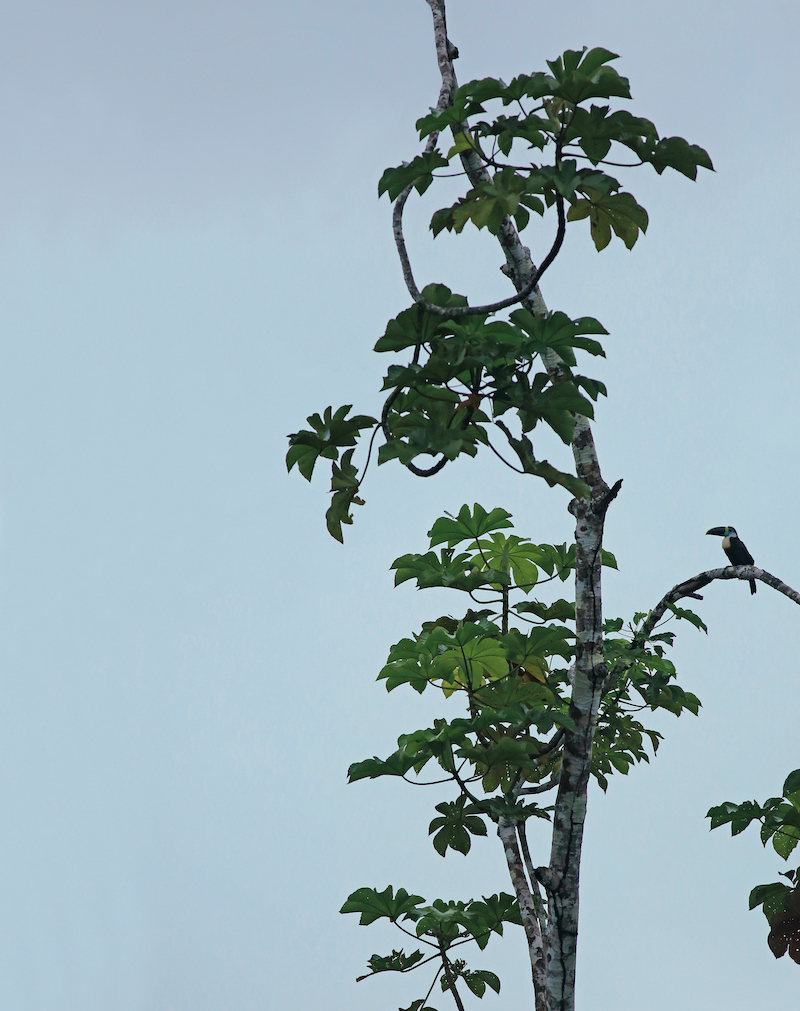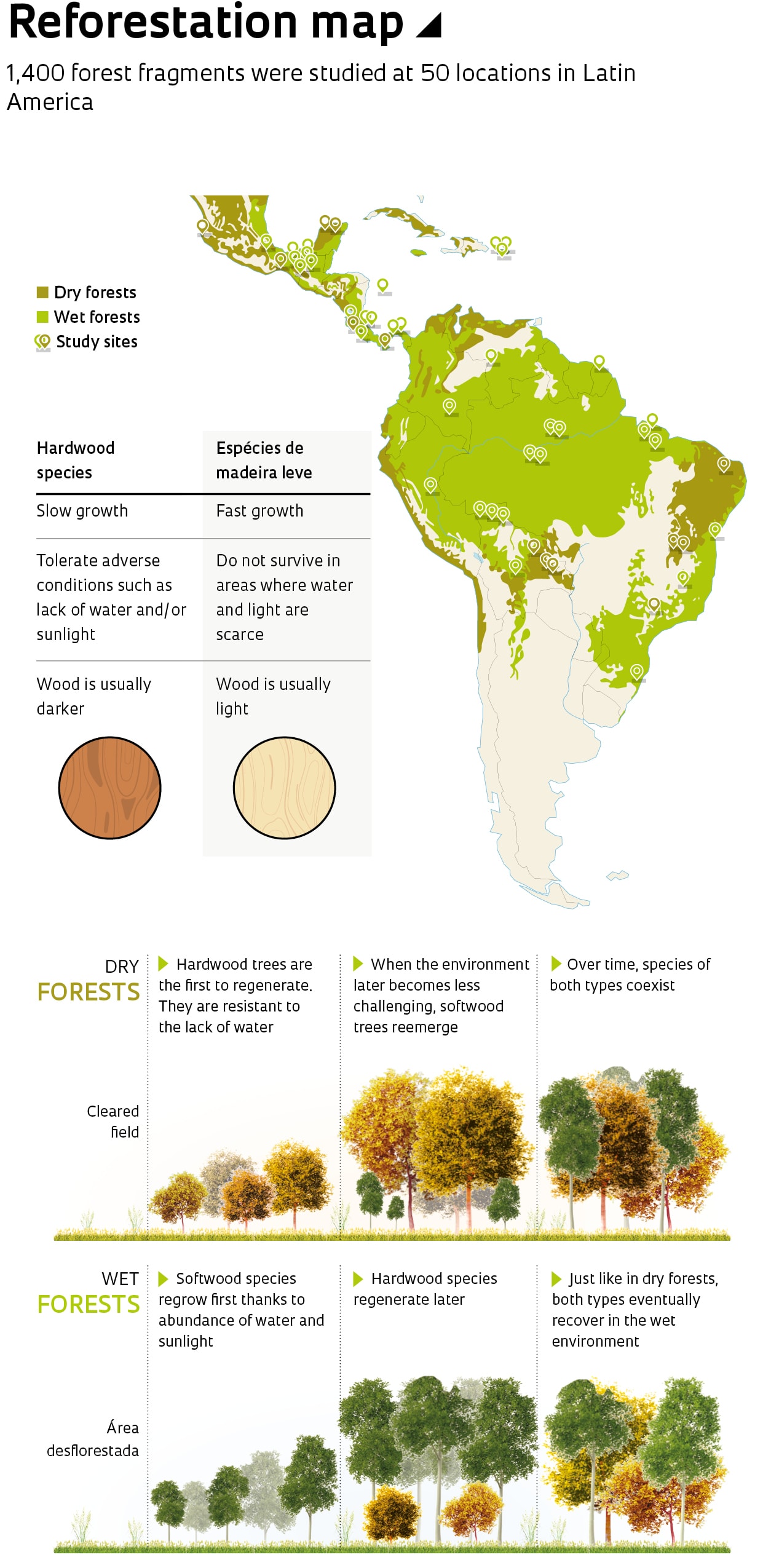An international collaboration of 85 researchers from 16 countries is attempting to better understand the mechanisms behind the regeneration of cleared tropical forests in Latin America. The most recent study by the group, named 2ndFOR, found that the composition of tree species that arise during the regrowing process—known as forest succession—depends on the wetness of the deforested area.
In an article published in the scientific journal Nature Ecology & Evolution on April 22, the scientists showed that in wetter tropical forests, the first species to regrow in deforested areas are the lighter and softer woods, which grow faster and are less commercially valuable. The denser, harder wooded trees, which take longer to develop and fetch a higher price on the market, regrow later. This is expected behavior, in line with traditional theories on the natural reforestation of degraded areas. But in drier forests, the opposite occurs: hardwood trees regrow first, followed later by softwood trees.
“We were surprised to see completely different succession pathways for forests in rainy and dry areas,” said Lourens Poorter, an ecologist from Wageningen University in the Netherlands and lead author of the study. The researchers also looked at forests in intermediate climates, midway between wet and dry. In these cases, they observed that the initial regeneration process includes both hard and soft trees. In the long run, after a few decades of regrowth, both dry and wet forests tend to converge, with numerous tree species of both types.
Carbon sequestration
The conclusions of the 2ndFOR study are based on a robust data set that allowed for comparisons between forests as different as the São Paulo Atlantic Forest, where the climate is relatively humid, and the Petén Basin in Mexico, which is an arid region. The group used data from more than 1,400 forest fragments analyzed at 50 of its 58 research sites. The chosen sampling locations featured naturally regenerated secondary forests of varying ages, ranging from forest fragments in the Brazilian state of Pará that were deforested 10 years ago to sites in Panama that were destroyed and abandoned 100 years ago.
The emphasis on reserving areas of forest for regeneration has grown in recent decades, mainly as a result of the discussion on climate change. As carbon dioxide (CO2) emission rates continue to rise, secondary forests have become more and more important in the fight against global warming because growing trees absorb more carbon.
Policymakers can therefore benefit from a better understanding of the reforestation process. New information can help them decide which areas should be prioritized and which strategies are most effective. “Based on this knowledge, for example, we can choose to plant hardwood tree species when restoring areas with soil degradation, anticipating the lack of water available to the plants there,” says agronomist Pedro Brancalion, from the Luís de Queiroz School of Agriculture at the University of São Paulo (ESALQ-USP), coauthor of the 2ndFOR study.
How wet or dry a forest is can drastically alter the way a deforested area begins its regeneration process. Some plant species need the forest canopy to protect them from the sun so that they do not dry out. In dry forests, therefore, dense hardwood trees, which are more tolerant of low water levels, fare better at the beginning of the reforestation process. Once they are established, the softer wood species, which die more easily when faced with a lack of water, follow behind.
In wet forest areas, because there are no severe droughts, the less dense woods regrow faster from the start, as they are more efficient at absorbing nutrients. This explains, for example, why cecropia trees, which are light and hollow, are abundant in secondary forests in rainier climates like the Amazon, while those in drier climates feature denser hardwood species.

Fabio Colombini
Cecropia tree in the Brazilian Amazon, one of the first species to regrow in wet forests
Fabio ColombiniLifestyle
The dynamics of reforestation depend on differences in metabolism that influence the “lifestyle” of trees. Species with conservative strategies do better in environments with fewer natural resources, such as in environments with poor soil, low light, and scarce water. They are thus predominant in forests with drier climates. Those with acquisitive strategies are more common in environments with greater access to resources, such as more fertile soil, and rainy and sunny locations. They are the first to reappear in rainforests, for example.
Climate change is the driving force behind many of the public policies adopted to regenerate deforested areas. A group of 30 countries have already committed to restoring 91 million hectares of forests—an area the size of Venezuela—by 2020. To meet the Paris Agreement’s CO2 reduction targets, 350 million hectares of deforested areas need to be recovered by 2030. How this will be achieved, no one knows.
According to studies by 2ndFOR, direct forest restoration strategies that involve the planting of seedlings do not always work. Soil degradation, fires, and competition with invasive plants can all compromise the results of this approach. “If possible, reforestation should rely on natural regeneration, known as passive restoration. It is cheaper and leads to more diverse and resilient vegetation,” says ecologist Ima Vieira, from the Emílio Goeldi Museum of Pará, an institution affiliated with 2ndFOR. “In degraded areas where natural regeneration is difficult, however, planting trees is a good alternative.”
Carbon sequestration should not be the only motivation for restoring forests, the researchers say. Forests are also associated with improved soil and water quality, and the biodiversity they sustain could provide new substances and biomaterials—not to mention the important role they play in the livelihoods of local communities. Even when considering biodiversity alone, analysis by 2ndFOR suggests that there are different ways of measuring the success of forest regeneration.
A paper published by the group in the journal Science Advances in March 2019 indicates that on average, secondary tropical forests need 20 years to recover 80% of the species richness found in a mature preserved forest. The time needed to equal the level of a mature forest is even longer. “Although most species recover quickly in a regrowing forest, it can take centuries before it has the same species richness as the original forest,” says Brancalion. “In fact, we don’t know if it’s possible to ever reach that point, because we usually have no idea of the diversity that existed in the deforested area in the past.”
Project
Chronosequence and effect of the landscape on the succession of secondary tropical forests (nº 14/14503-7); Grant Mechanism PhD Grant; Principal Investigator Pedro Brancalion (USP); Beneficiary Ricardo Gomes César; Investment R$168,055.58.
Scientific articles
POORTER, L. et al. Wet and dry tropical forests show opposite successional pathways in wood density but converge over time. Nature Ecology & Evolution. Apr. 22, 2019.
ROZENDAAL, D. M. A. et al. Biodiversity recovery of Neotropical secondary forests. Science Advances. Mar. 6, 2019.
Republish

